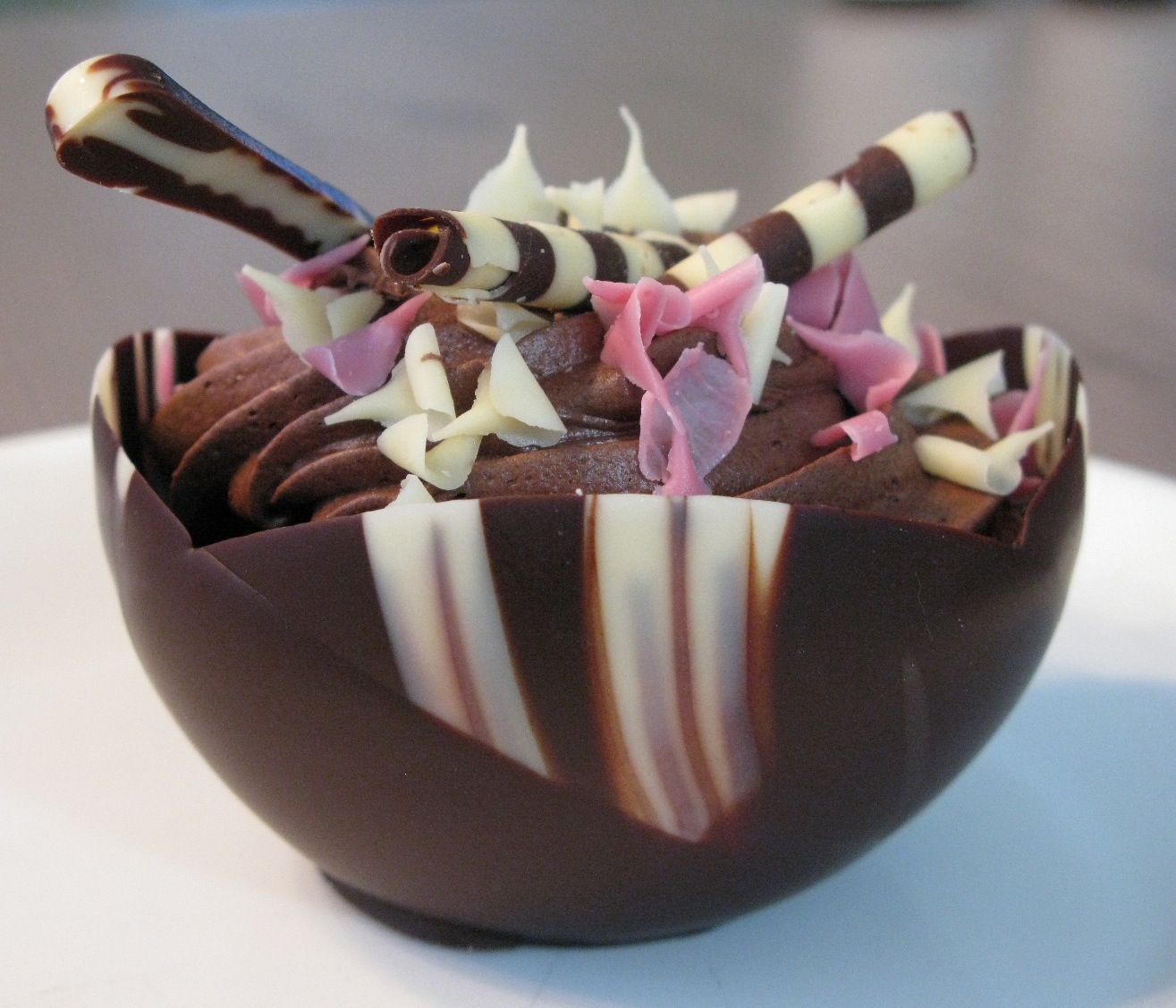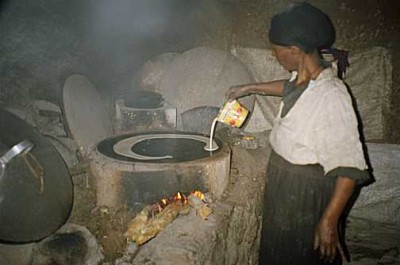|
Trencher (tableware)
A trencher (from Old French ''tranchier'' 'to cut') is a type of tableware, commonly used in medieval cuisine. A trencher was originally a flat round of (usually stale) bread used as a plate, upon which the food could be placed to eat. At the end of the meal, the trencher could be eaten with sauce, but could also be given as alms to the poor. Later the trencher evolved into a small plate of metal or wood, typically circular and completely flat, without the lip or raised edge of a plate. Trenchers of this type are still used, typically for serving food that does not involve liquid; for example, the cheeseboard. In language An individual salt dish or squat open salt cellar placed near a trencher was called a "trencher salt". A "trencherman" is a person devoted to eating and drinking, often to excess; one with a hearty appetite, a gourmand. A secondary use, generally archaic, is one who frequents another's table, in essence a pilferer of another's food. A "trencher-fed pack" is ... [...More Info...] [...Related Items...] OR: [Wikipedia] [Google] [Baidu] |
Trencher From The Estate Of Stola In Vastergotland, Inscription Written By Johan Ekeblad, Swedish Ambassador To Paris In 1685, Object Dates To Mid 1600s - Nordiska Museet - Stockholm, Sweden - DSC09788
Trencher may refer to: * Trencher (comics), a comic book series * Trencher (machine), a digging machine * Trencher (tableware), a place setting item (originally a flat round of bread) * Trencher cap, a square academic cap The square academic cap, graduate cap, cap, mortarboard (because of its similarity in appearance to the mortarboard used by brickmasons to hold mortar) or Oxford cap is an item of academic dress consisting of a horizontal square board fixed up ... * Trencher (band), a London-based Casio-core band {{disambig ... [...More Info...] [...Related Items...] OR: [Wikipedia] [Google] [Baidu] |
Dido (Queen Of Carthage)
Dido ( ; , ), also known as Elissa ( , ), was the legendary founder and first queen of the Phoenician city-state of Ancient Carthage, Carthage (located in modern Tunisia), in 814 BC. In most accounts, she was the queen of the Phoenician city-state of Tyre, Lebanon, Tyre (today in Lebanon) who fled tyranny to found her own city in northwest Africa. Known only through ancient Greece, ancient Greek and ancient Rome, Roman sources, all of which were written well after Carthage's founding, her historicity remains uncertain. The oldest references to Dido are attributed to Timaeus (historian), Timaeus, who was active around 300 BC, or about five centuries after the date given for the foundation of Carthage. Details about Dido's character, life, and role in the founding of Carthage are best known from the account given in Virgil's Epic poetry, epic poem, the ''Aeneid,'' written around 20 BC, which tells the legendary story of the Trojan War, Trojan hero Aeneas. Dido is described as a ... [...More Info...] [...Related Items...] OR: [Wikipedia] [Google] [Baidu] |
Great Hall
A great hall is the main room of a royal palace, castle or a large manor house or hall house in the Middle Ages, and continued to be built in the country houses of the 16th and early 17th centuries, although by then the family used the great chamber for eating and relaxing. At that time the word "great" simply meant big and had not acquired its modern connotations of excellence. In the medieval period, the room would simply have been referred to as the "hall" unless the building also had a secondary hall, but the term "great hall" has been predominant for surviving rooms of this type for several centuries, to distinguish them from the different type of hall found in post-medieval houses. Great halls were found especially in France, England and Scotland, but similar rooms were also found in some other European countries. A typical great hall was a rectangular room between one and a half and three times as long as it was wide, and also higher than it was wide. It was enter ... [...More Info...] [...Related Items...] OR: [Wikipedia] [Google] [Baidu] |
Frumenty
Frumenty (sometimes ''frumentee'', ''furmity'', ''fromity'', or ''fermenty'') was a popular dish in Western European medieval cuisine. It is a porridge, a thick boiled grain dish—hence its name, which derives from the Latin word ''frumentum'', "grain". It was usually made with cracked wheat boiled with either milk or broth and was a peasant staple. More luxurious recipes include eggs, almonds, currants, sugar, saffron and orange flower water. Frumenty was served with meat as a pottage, traditionally with venison or even porpoise (considered a "fish" and therefore appropriate for Lent). It was also frequently used as a subtlety, a dish between courses at a banquet. In England History Florence White, founder of the English Folk Cookery Association, wrote in '' Good Things in England'' (1932) that frumenty is England's "oldest national dish". For several centuries, frumenty was part of the traditional Celtic Christmas meal. According to an 1822 ''Time's Telescope'', in Yorks ... [...More Info...] [...Related Items...] OR: [Wikipedia] [Google] [Baidu] |
Edible Tableware
Edible tableware is tableware, such as plates, drinkware glasses, utensils and cutlery, that is edible. Edible tableware can be homemade and has also been mass-produced by some companies, and can be prepared using many various foods. Overview Edible tableware can be homemade or mass-produced, and is prepared from various foods. For example, homemade tableware can be fashioned using sliced celery as chopsticks, and celery can also be used to scoop foods such as dips and cream cheese. A leaf of cabbage can be used as a spoon, and a carrot stick that has been sharpened can be used as a skewer. Edible bowls and plates can be prepared with many methods. Bread which has had its center removed can be used for soups, and similarly, baking cheese in an oven and forming the cheese into the desired shape. Chocolate can also be fashioned into edible tableware. Flatbread such as khobez is sometimes used as an eating utensil, such as when it is used to scoop hummus, and Ethiopian injera bre ... [...More Info...] [...Related Items...] OR: [Wikipedia] [Google] [Baidu] |
Injera
Injera (, ; om, Biddeena; ) is a sour fermented pancake-like flatbread with a slightly spongy texture, traditionally made of teff flour. In Ethiopia, Eritrea, and some parts of Sudan, injera is the staple. Injera is central to the dining process, like bread or rice elsewhere. Ingredients Traditionally, injera is made with just two ingredients – teff flour and water. Teff flour is ground from the grains of '' Eragrostis tef'', also known as teff, an ancient cereal crop from the Ethiopian Highlands. Teff production is limited to certain middle elevations with adequate rainfall, and, as it is a low-yield crop, it is relatively expensive for the average farming household. As many farmers in the Ethiopian highlands grow their own subsistence grains, wheat, barley, corn, or rice flour are sometimes used to replace some or all of the teff content. Teff seeds are graded according to color, used to make different kinds of injera: ''nech'' (white), ''key'' or ''quey'' (red), ... [...More Info...] [...Related Items...] OR: [Wikipedia] [Google] [Baidu] |
Bread Bowl
A bread bowl is a round loaf of bread which has had the top cut off and a large portion of the middle hollowed out to create an edible bowl. They are typically larger than a roll but smaller than a full sized loaf of bread. Bread bowls can be used to serve chili, New England-style clam chowder, and other thick stews (often, but not always, with a cheese or cream base). Soups with thinner bases are not generally served in bread bowls, as the broth would make the bread get too soggy too quickly. The bread becomes flavored as it absorbs some of the stew's base, and can be eaten after the stew has been eaten. Bread bowls are also used for dips, using the scooped-out bread for dipping. Variations A British firm has marketed naan bowls filled with chicken tikka masala. Spinach dip made with dehydrated vegetable soup mix is often served in a round pumpernickel bread loaf. Coffin lid "Coffin lid" or " coffin bread" () is a Taiwanese variant developed in Tainan. It uses Texa ... [...More Info...] [...Related Items...] OR: [Wikipedia] [Google] [Baidu] |
A Dance With Dragons
''A Dance with Dragons'' is the fifth novel of seven planned in the epic fantasy series ''A Song of Ice and Fire'' by American author George R. R. Martin. In some areas, the paperback edition was published in two parts, titled ''Dreams and Dust'' and ''After the Feast''. It was the only novel in the series to be published during the eight-season run of the HBO adaptation of the series, ''Game of Thrones'', and runs to 1,040 pages with a word count of almost 415,000. The US hardcover was officially published on July 12, 2011, and a few weeks later went to No. 1 on both '' Publishers Weekly'' and '' USA Today'' bestsellers lists. The novel has been adapted for television as the fifth season of ''Game of Thrones'', although elements of the book have also appeared in the series' third, fourth and sixth seasons. Plot summary The Wall and beyond Stannis Baratheon, a claimant to the Iron Throne of Westeros, occupies the Wall at the realm's northern border, having helped to r ... [...More Info...] [...Related Items...] OR: [Wikipedia] [Google] [Baidu] |
A Song Of Ice And Fire
''A Song of Ice and Fire'' is a series of epic fantasy novels by the American novelist and screenwriter George R. R. Martin. He began the first volume of the series, '' A Game of Thrones'', in 1991, and it was published in 1996. Martin, who initially envisioned the series as a trilogy, has published five out of a planned seven volumes. The fifth and most recent volume of the series, '' A Dance with Dragons'', was published in 2011, six years after the publication of the preceding book, '' A Feast for Crows''. He is currently writing the sixth novel, '' The Winds of Winter''. A seventh novel, ''A Dream of Spring'', is planned. ''A Song of Ice and Fire'' takes place on the fictional continents Westeros and Essos. The point of view of each chapter in the story is a limited perspective of a range of characters growing from nine in the first novel, to 31 characters by the fifth novel. Three main stories interweave: a dynastic war among several families for control of Westeros, th ... [...More Info...] [...Related Items...] OR: [Wikipedia] [Google] [Baidu] |
George R
George may refer to: People * George (given name) * George (surname) * George (singer), American-Canadian singer George Nozuka, known by the mononym George * George Washington, First President of the United States * George W. Bush, 43rd President of the United States * George H. W. Bush, 41st President of the United States * George V, King of Great Britain, Ireland, the British Dominions and Emperor of India from 1910-1936 * George VI, King of Great Britain, Ireland, the British Dominions and Emperor of India from 1936-1952 * Prince George of Wales * George Papagheorghe also known as Jorge / GEØRGE * George, stage name of Giorgio Moroder * George Harrison, an English musician and singer-songwriter Places South Africa * George, Western Cape ** George Airport United States * George, Iowa * George, Missouri * George, Washington * George County, Mississippi * George Air Force Base, a former U.S. Air Force base located in California Characters * George (Peppa Pig), ... [...More Info...] [...Related Items...] OR: [Wikipedia] [Google] [Baidu] |
Shakespeare
William Shakespeare ( 26 April 1564 – 23 April 1616) was an English playwright, poet and actor. He is widely regarded as the greatest writer in the English language and the world's pre-eminent dramatist. He is often called England's national poet and the " Bard of Avon" (or simply "the Bard"). His extant works, including collaborations, consist of some 39 plays, 154 sonnets, three long narrative poems, and a few other verses, some of uncertain authorship. His plays have been translated into every major living language and are performed more often than those of any other playwright. He remains arguably the most influential writer in the English language, and his works continue to be studied and reinterpreted. Shakespeare was born and raised in Stratford-upon-Avon, Warwickshire. At the age of 18, he married Anne Hathaway, with whom he had three children: Susanna, and twins Hamnet and Judith. Sometime between 1585 and 1592, he began a successful career in London as an ... [...More Info...] [...Related Items...] OR: [Wikipedia] [Google] [Baidu] |
Allen Tate
John Orley Allen Tate (November 19, 1899 – February 9, 1979), known professionally as Allen Tate, was an American poet, essayist, social commentator, and poet laureate from 1943 to 1944. Life Early years Tate was born near Winchester, Kentucky, to John Orley Tate, a Kentucky businessman and Eleanor Parke Custis Varnell from Virginia. On the Bogan side of her grandmother's family Eleanor Varnell was a distant relative of George Washington; she left Tate a copper luster pitcher that Washington had ordered from London for his sister. In 1916 and 1917 Tate studied the violin at the Cincinnati Conservatory of Music. College and the Fugitives Tate entered Vanderbilt University in 1918. He was the first undergraduate to be invited to join a group of men who met regularly to read and discuss their poetry: they included John Crowe Ransom and Donald Davidson on the faculty; James M. Frank, a prominent Nashville businessman who hosted the meetings; and Sidney Mttron Hirsch, ... [...More Info...] [...Related Items...] OR: [Wikipedia] [Google] [Baidu] |







